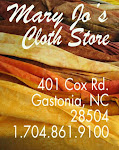It’s that time of year again - the time when your favorite fabrics are reduced to unbelievable prices, when professional demonstrations are free to all and when you can tenderly caress fabrics in public and not be judged; it’s Girl’s Day Out at Mary Jo’s!
After such a phenomenal response last year, Girl’s Day Out is returning for a second time. If you weren’t able to join in the fun last year, don’t sweat it. We have compiled the top 6 tips on how you can get the most out of our one day extravaganza that is Girl’s Day Out.
1. Arrive early
- Doors opening at 9 a.m. didn’t stop our fabulous fans from arriving in the wee hours of the morning to camp out in a line that wrapped around the store last year. The same goes for this year, if you want to be one of the first 100 shoppers in line to receive a free gift we recommend grabbing some chairs and claiming your spot in line, early! Plus one lucky winner will win FREE FABRIC for a year!
2. Be prepared
- With only so many hours in the day and plenty of demonstrations to see, fabrics to purchase and prizes to win, having a plan of attack can make all the difference. Plan ahead, and know which fabrics you can’t leave without and what time your demonstration is starting. The best way to do that? Join the Girl’s Day Out Facebook page for all of the latest event details and information! And don’t forget to sign up for our newsletter - we’ll release the final sale items!
3. Use the buddy system
- Girl’s Day Out is all about the girls! Bring a friend and enjoy the ultimate ‘shop til you drop’ experience. Better yet, you can even have your partner in crime help scope out the next sale section while you finish getting your fabric cut. Team work!
4. Treat yourself
- At Mary Jo’s, we love our customers! That is why our entire Girl’s Day Out event is centered on you. It’s our own personal way of saying thank you for the love. How are we doing that? Not only have we worked with vendors to negotiate specialty pricing on fabric, but we have secured amazing prizes that we will be giving away every 30 minutes all day long!
5. Boys are allowed
- While we do love our ladies at Mary Jo’s, the fellas are just as fun! Everyone is welcome, from hubbies to male sewing aficionados. Featuring home décor demos, giveaways and even a designated husband lounging space, everyone can find something to enjoy at our Girl’s Day Out event.
6. No excuses
- Don’t live nearby? No sweat! We have partnered with Hampton Inn (1859 Remount Road, Gastonia NC 28054) for a $69 a night rate for all Mary Jo’s customers. Call 704.866.9090 to book your room today. Still can’t make it? Guess what, the sale will be offered online too! Shop your favorites with one click of the mouse at maryjos.com.
































